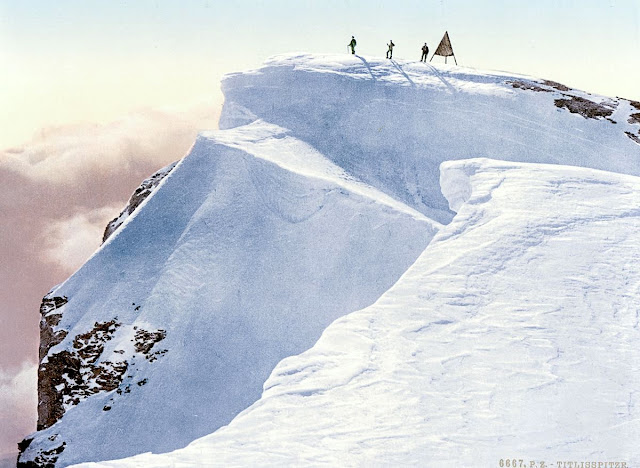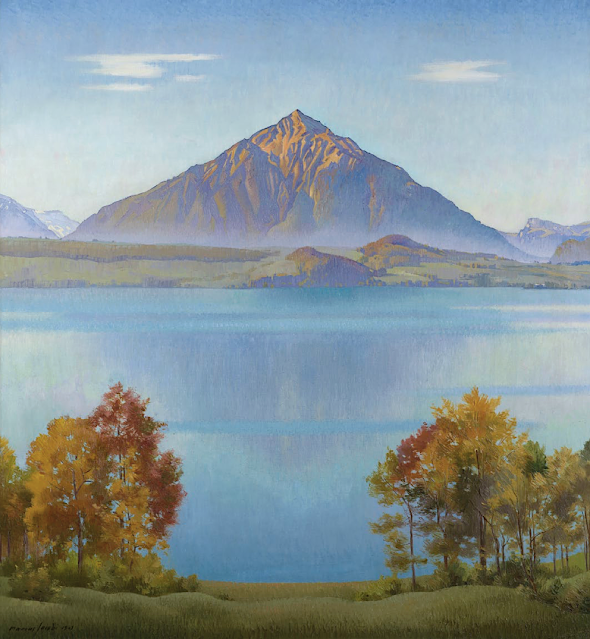Niesen (2, 362m - 7,749ft)
Suisse
In Full Moon, Huile sur toile, 1919
Le Niesen (2, 362m - 7,749ft) i est une montagne des Alpes bernoises en Suisse. Il surplombe le lac de Thoune, dans la région de l'Oberland bernois, et forme l'extrémité nord d'une crête qui s'étend au nord de l'Albristhorn et du Mannliflue, séparant les vallées du Simmental et du Kandertal. La traduction littérale du mot allemand « Niesen » est « éternuement », mais le Niesen, en raison de sa forme, est souvent appelé la "pyramide suisse". Sur le plan administratif, le sommet est partagé entre les communes de Reichenbach im Kandertal, au sud-est, et de Wimmis, à l'ouest et au nord. Les deux communes font partie du canton de Berne. Le sommet de la montagne est facilement accessible en empruntant le funiculaire Niesenbahn depuis Mülenen (près de Reichenbach). Depuis le XVIIIe siècle, le Niesen a fait l'objet de nombreuses peintures qui seront toutes publiées une à une dans ce blog. Les tableaux de Ferdinand Holder sont les deux premiers à avoir été publiés. Le Niesen a également fait l'objet de nombreux tableaux de Paul Klee, dans lesquels il est représenté sous la forme d'une quasi-pyramide au centre du tableau.
Le peintre
Paul Klee était un artiste suisse-allemand. Son style a été influencé par l'expressionnisme, le cubisme et le surréalisme. Klee était un dessinateur qui expérimenta et explora en profondeur la théorie des couleurs, écrivant abondamment sur ce sujet ; ses conférences Écrits sur la théorie de la forme et du design (Schriften zur Form und Gestaltungslehre), publiés en anglais sous le nom de Cahiers Paul Klee, sont considérés comme aussi importants pour l'art moderne que le Traité sur la peinture pour la Renaissance de Léonard de Vinci. Lui et son collègue, le peintre russe Vassily Kandinsky, ont tous deux enseigné à l'Ecole d'art, de design et d'architecture du Bauhaus. Ses œuvres reflètent son humour sec et son point de vue parfois enfantin, ses humeurs et convictions personnelles, ainsi que sa musicalité.
Klee a été diversement associé à l'expressionnisme, au cubisme, au futurisme, au surréalisme et à l'abstraction, mais ses toiles sont difficiles à classer. Il interprétait généralement les nouvelles tendances artistiques à sa manière. Il était inventif dans ses méthodes et sa technique. Klee a travaillé avec de nombreux supports différents : peinture à l'huile, aquarelle, encre, pastel, eau-forte et autres. Il les combinait souvent en une seule œuvre. Il a utilisé de la toile, de la toile de jute, de la mousseline, du lin, de la gaze, du carton, des feuilles métalliques, du tissu, du papier peint et du papier journal. Klee a utilisé de la peinture en aérosol, l'application au couteau, l'estampage, le glaçage et l'empâtement, ainsi que des techniques mixtes telles que l'huile avec aquarelle, l'aquarelle avec stylo et encre de Chine et l'huile avec détrempe. Il utilisait souvent des formes géométriques ainsi que des lettres, des chiffres et des flèches, et les combinait avec des figures d'animaux et de personnes. Certaines œuvres étaient complètement abstraites. Beaucoup de ses œuvres et leurs titres reflètent son humour sec et ses humeurs variées ; certains expriment des convictions politiques. Ils font fréquemment allusion à la poésie, à la musique et aux rêves et incluent parfois des mots ou des notations musicales. Les œuvres ultérieures se distinguent par des symboles ressemblant à des hiéroglyphes en forme d'araignée. Rainer Maria Rilke écrivait à propos de Klee en 1921 : « Même si vous ne m'aviez pas dit qu'il jouait du violon, j'aurais deviné qu'à plusieurs reprises ses dessins étaient des transcriptions de musique. »
2024 - Gravir les montagnes en peinture
Un blog de Francis Rousseau
%20%20%20Der%20Niesen%20%20(2,%20362m%20-%207,749ft)%20Switzerland.jpg)
-%20the%20Monk%201914%20.png)



,%20Savie%CC%80se%20in%20Valais%20(Morning%20in%20the%20mountains),%201912.png)










